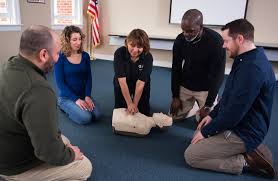Introduction
In today's busy work environment, security is critical. Organizations are progressively recognizing the relevance of creating a secure space for employees. Among one of the most essential components of work environment security training is first help and CPR (Cardiopulmonary Resuscitation) courses. These programs not only empower employees with important life-saving abilities however likewise promote a society of safety and security within the company. In this short article, we will look into the myriad reasons that office safety and security training should consist of first aid and CPR courses, highlighting their significance in boosting work environment safety.

Why Workplace Safety Training Must Consist Of Emergency Treatment and Mouth-to-mouth Resuscitation Courses
The integration of first aid and CPR courses right into work environment security training has far-ranging advantages. They furnish staff members with the understanding and skills essential to respond successfully to clinical emergencies, reduce healing time for injured individuals, and potentially conserve lives. Additionally, having trained employees on-site can instill confidence among staff members and comfort them that their well-being is prioritized.

Understanding Initial Aid
First aid describes the immediate treatment offered to a specific suffering from a small or significant disease or injury till professional medical help arrives. Comprehending fundamental emergency treatment concepts can make a substantial distinction in emergency situations.
Key Components of First Aid
Assessment: The ability to assess a situation promptly can assist establish the appropriate activities needed. Stabilization: Comprehending exactly how to support a harmed person prevents more harm. Communication: Effectively connecting with emergency solutions is essential for timely assistance.The Value of CPR
CPR is a life-saving method used in emergencies when someone's heartbeat or breathing has actually stopped. It includes upper body compressions and rescue breaths to maintain blood flow and oxygenation up until professional assistance arrives.
How mouth-to-mouth resuscitation Works
- Chest Compressions: These assist circulate blood throughout the body. Rescue Breaths: These provide oxygen to the lungs.
Benefits of Emergency treatment and Mouth-to-mouth Resuscitation Certification
Obtaining an emergency treatment certification or completing CPR courses features various benefits, both for people and organizations.
Enhanced Employee Confidence: Employees really feel extra protected recognizing they possess life-saving skills. Reduced Healing Time: Quick action via first aid can cause far better end results for damaged individuals. Compliance with Regulations: Many industries need qualified employees as part of their health and wellness regulations.
Creating a Society of Safety And Security Through Training
Implementing first aid and mouth-to-mouth resuscitation training fosters a society that focuses on worker wellness.
Encouraging Teamwork
Training sessions commonly entail team-building exercises that boost collaboration amongst employees.
Building Count on Between Workers and Management
When monitoring invests in staff member training, it shows commitment to their wellness, leading to boosted morale.
First Help Gushes vs. CPR Courses: What's the Difference?
While both kinds of programs are necessary, they concentrate on various skill sets.
First Aid Courses
These courses cover a variety of topics beyond just heart emergencies, including:
- Wound care Burns Choking
CPR Courses
CPR courses specifically concentrate on strategies related to heart attack scenarios, emphasizing:
- Adult CPR Child/ baby resuscitation Use of an Automated External Defibrillator (AED)
Choosing the Right Training Provider
Not all training service providers are developed equal; as a result, picking one that meets your company's needs is find CPR courses near Hobart critical.
Accreditation Matters
Ensure that your picked carrier uses recognized courses recognized by relevant authorities.
Instructor Experience
Consider instructors' certifications; knowledgeable trainers typically supply richer discovering experiences via real-world examples.
Incorporating First Aid right into Workplace Safety Policies
Organizations should incorporate emergency treatment demands into their broader safety plans for thorough coverage.
Regular Training Updates
Conducting regular refresher courses ensures that expertise stays existing among employees.
Creating Emergency Response Plans
Having clear strategies in place can guide trained workers throughout emergencies.
Legal Ramifications of First Aid Training in the Workplace
Employers have lawful responsibilities regarding office safety; executing emergency treatment training can aid reduce threats associated with non-compliance.
Negligence Claims
Failure to offer adequate training may leave companies at risk to lawsuits if an incident happens due to lack of preparedness.

FAQ Section
What is included in a normal emergency treatment course?- A common emergency treatment course consists of guideline on analyzing injuries, treating wounds, managing burns, managing choking occurrences, and doing CPR if necessary.
- Most CPR courses last between 4-- 6 hours depending on whether it's standard or advanced training.
- While not always legitimately mandated, having licensed staff members can dramatically boost workplace security standards.
- Many certified organizations supply on the internet revival alternatives for emergency treatment certificates which include assessments through video conferencing.
- Yes, industries such as construction, health care, education, and production usually have regulatory needs requiring skilled workers on site.
- It's advised that employees take part in correspondence course every two years or faster if there are substantial changes in procedures or regulations.
Conclusion
To summarize, incorporating emergency treatment and mouth-to-mouth resuscitation right into work environment safety and security training is not simply an option but a need in today's work environments where emergency situations can arise anytime. Organizations benefit tremendously from having actually educated workers ready to respond properly during situations while fostering an environment where worker wellness takes priority over all else. Therefore, it ends up being obvious why workplace safety and security training must consist of emergency treatment and CPR courses-- they save lives while advertising an aggressive strategy toward health and safety standards within companies across numerous sectors.
By prioritizing such vital training initiatives-- emergency treatment certifications acquired with trustworthy suppliers along with useful hands-on experience-- business can considerably boost their general emergency preparedness degrees while likewise constructing more powerful teams capable of taking on any kind of scenario head-on!